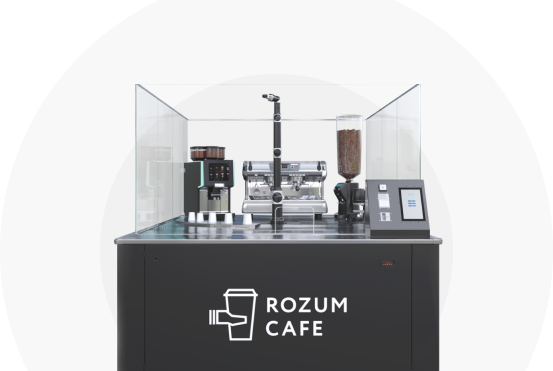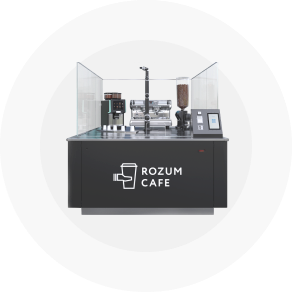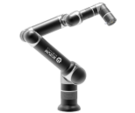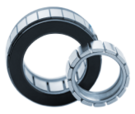Some manufacturers would argue that a combination of a brushless motor and an encoder already make a servomechanism. In fact, basic components are there — a propulsor to produce mechanical power and a feedback device, such as an encoder, to confirm the propulsor movements where and how it actually should.
However, Rozum Robotics has gone way further, embedding a gearhead to multiply torque and a controller to eliminate the need to use an external controller kit (otherwise known as servo drive). Let us have a closer look at the original lineup of servo motors developed by the company experts.
DC servo motors with AC core
As controversial as it sounds, RDrive-series servo motors work with both types of current supply — alternating (AC) and direct (DC). After DC power is fed to the actuator input, a dedicated controller module takes up and converts it into AC flow, transferring it to the brushless motor at the core. In this way, our servos get the best of the two different technologies:
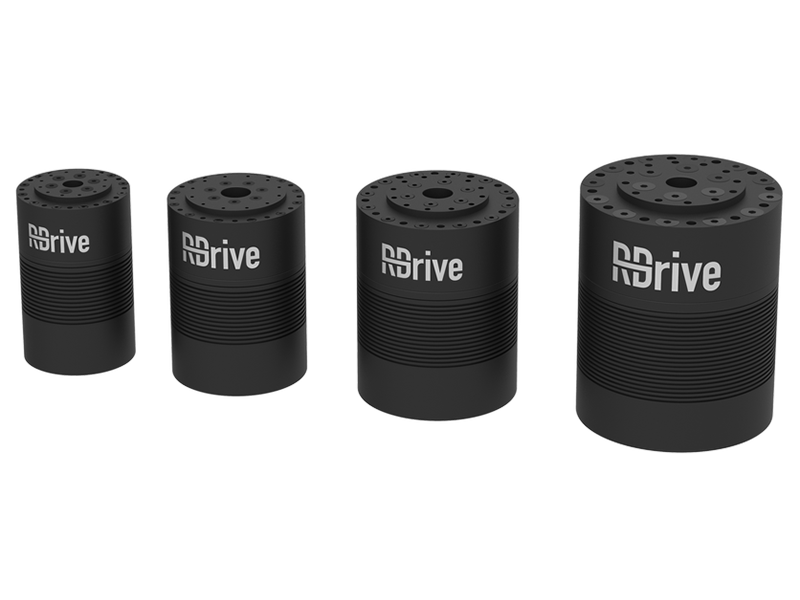
As direct-current servomechanisms
Significant power outturn in a small size Efficiency reaching 90% at light loads Rapid acceleration due to torque generation exceeding materially motor inertia With emergency reserve provisions, capable of producing for a short duration up to five times as much power and up to ten times as much torque as in normal conditions Delivers high torque even within the top velocity span Causes no vibration- or resonance-related issues
As brushless alternating-current motors
Enhanced stability and smooth operation No brushes means no sparks and high-grade safety and integrity Brushless design translates into reduced wear and, consequently, less maintenance expenses and longer life-in-service Generate low noise when running.
All-in-one motion solution
Designing the servo lineup, experts at Rozum Robotics packed the AC brushless motor into a single shell with a controller, two encoders, and a gearhead.
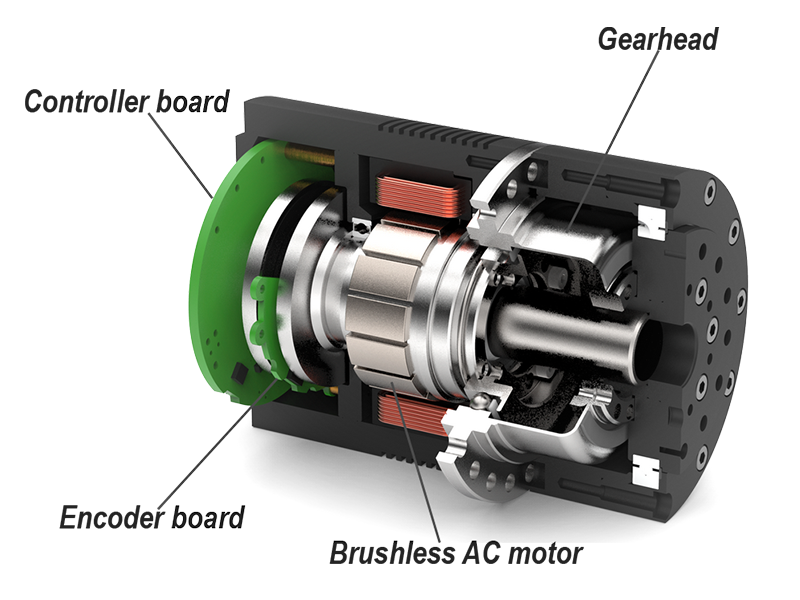
Controller
The controller is embedded into the housing on an individual printed circuit board (PCB). Experts at Rozum Robotics tuned it to match two encoders supplying it with process data and the propulsor moving in accordance with commanded parameters. Communication with position sensors is via a BiSS interface ensuring continuous high-speed transmission of multiple readings. Commands to the motor are transmitted as pulse-width modulation signals.
Controllers interact with external controlling devices and process feedback. Furthermore, the devices handle temperature sensor readings and perform calculations to derive motion parameters (e.g., speed) based on encoder measurements.
Encoders
The feedback mechanism in RDrive-range servo motors relies on the magnetic technology to track propulsion and returns absolute — i.e., exact — angular positions. In fact, the mechanism comprises two sensing elements built into the servo casing as a single PCB. The elements provide readings at two different locations — at the frameless motor shaft and at the output shaft. The distributed measurements allow to achieve top-notch accuracy of measurements, making up for possible errors due to the gearing effect.
The encoders have small dimensions and rugged construction. Though being a relatively low-cost solution, the devices boast 19-bit resolution. Structurally, the sensors include no direct-contact moveable parts, which minimizes failure and error rates due to wear and eliminates the need for specialized maintenance.
Gearbox
The harmonic gearhead in servo motors by Rozum Robotics is the power underlying the product’s outstanding torque density and power-to-weight ratio. Integration of the metal gearing set enables multiplying moment of force by nearly 100 times.
The strain-wave structural design eliminates backlash almost entirely—as a result, no downgrading of positioning precision due to gearing. In addition, the technology makes it possible to minimize gear-related servo failures, while improving durability.
Major features and operation principle
About ninety percent of the structural elements in RDrive servo motors are self-engineered. The company is almost entirely in control over the manufacturing process, delivering quality products with top-grade parameters and characteristics:
- Hollow-shaft mount for plug-and-run usage
- Space-saving design with all components neatly packed into a cylinder-shaped narrow-diameter body
- 3H performance — High torque (up to 333 Nm), High power (up to 680 W), High precision (up to 0.01 degree)
- Extended service life — 35,000 hours
Similarly to servomechanisms of other manufacturers, the actuators run on pulse-width modulation. This is a type of digital signal, where on and off phases are cycled in a predetermined fashion to attain desired motor behaviour. Parameters of importance are the on phase width, dictating where servos should move, and pulse period, defining how fast new commands can come in.
On a higher level, servo control is implemented using the CANOpen communication profile. The utilized CAN-based set of protocols makes it possible to create entire networks of engines, managing them all from a single master device. To regulate an RDrive servomechanism from a computer, one can also use the Application Programming Interface (User API) in C, Python, and Java implementations.
Versatile usage options
With particular features and properties as described above, RDrive-series servos cater to the following major domains:
- Industrial automation: In CNC machinery, the actuators aid in precise positioning of tooling and work surfaces. Metal - or wood-cutting machines benefit from their outstanding repeatability and accuracy. When driving assembly and packing lines, as well as other types of conveyor-belt systems, the servo motors ensure neat and regular propulsion.
-
Robotics: RDrive motors possess all the right features to provide driving force for a robot. Hollow-shaft design to build them easily into different machinery. Sufficient torque to bend and reposition robotic limbs and loads, as well as to hold required angles for as long as needed. Inch-perfect precision to set programmable machines into desired poses and execute specified motion trajectories with super exactitude.
Customization allows to extend application areas beyond the two large domains. Rozum Robotics is ready to deliver a custom solution, based on its standard servo lineup or your exact requirements.
Average lead-processing time, from request placement to delivery, is 2-8 weeks. All servo motors are covered by 1-YEAR WARRANTY. To guarantee correct and safe operation of the products in your application, Rozum Robotics offers an accessory — the servobox kit.
In-house experts and a network of local dealers are there to provide consultations and support at short notice. You can also find detailed video instructions and technical documentation at the company’s website.
